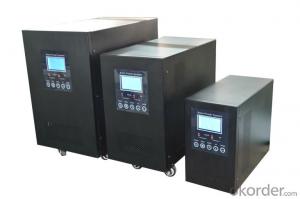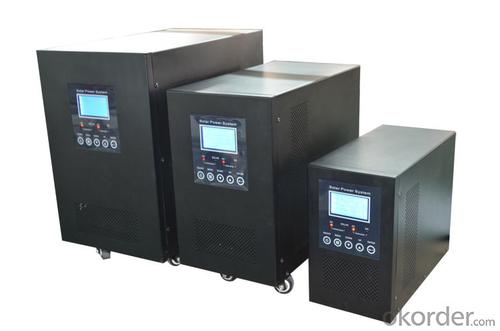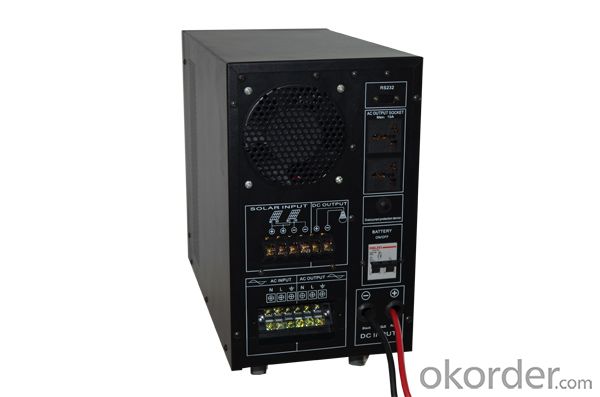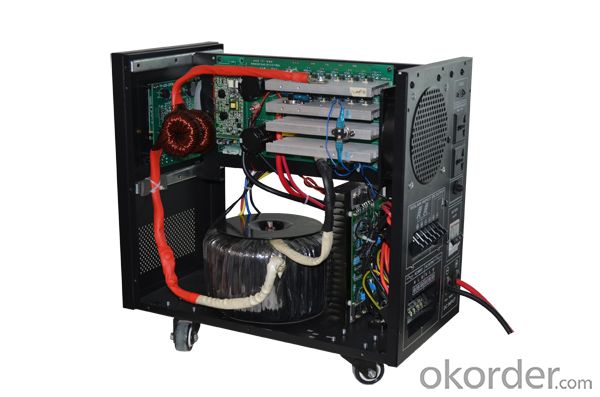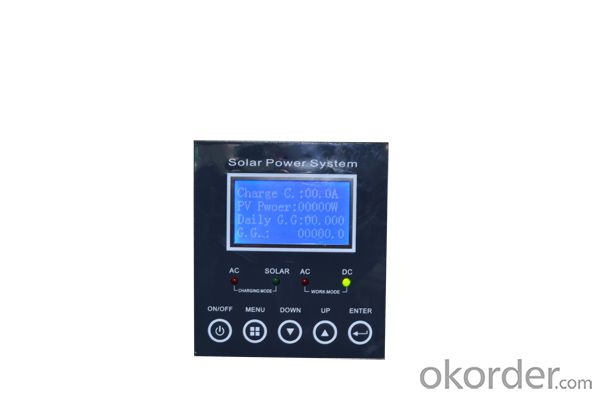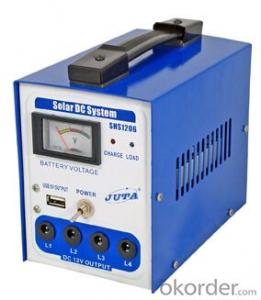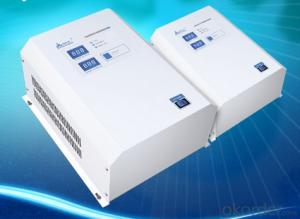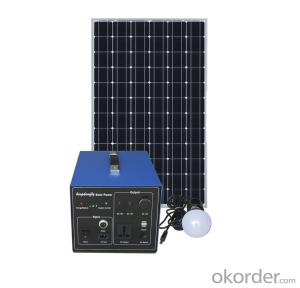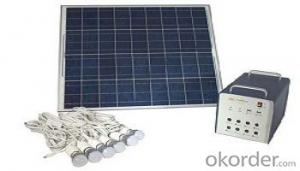Solar Energy Systems Maine:Solar Generator Intelligent Inverter with Charger
- Loading Port:
- Guangzhou
- Payment Terms:
- TT OR LC
- Min Order Qty:
- 50 pc
- Supply Capability:
- 100000 pc/month
OKorder Service Pledge
OKorder Financial Service
You Might Also Like
Solar Generator Intelligent Inverter with Charger
Feature
XZ-NK New intelligent inverter with built in controller realize to combine display of inverter and solar controller, which is different with tranditional solar generator.
2.With great function,display the parameter of solar controller and inverter at the same time, includes grid voltage, frequency, input voltage, input frequency, input wattage,output load precent,battery capacity precent,PV voltage, battery voltage, charge current,PV power, daily power generation, total power generation etc;
3.Realize customer self setting PV priority or Battery priority, setting of battery type,charge voltage, charge current, charge limit and so on;
4.Have time colock, timing turn on and off, keep record of fault, fault query more function.
5.Also with normal funtion of inverter, like protection against battery under voltage,over-voltage,overload,short circuit.
Aplication:
Mobile Charge,PC,Lighting Fixture,TV, Fan,Refrigerator,washing machine,air condition, water pump,safety products, professional tool, equipment etc any wattage electrical appliance.
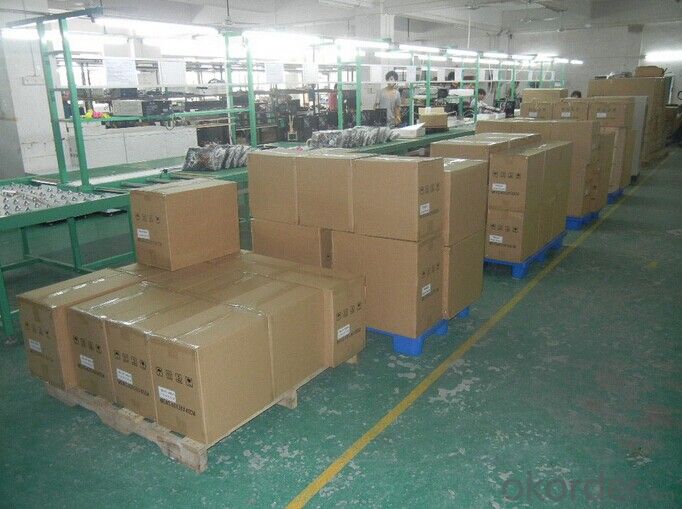
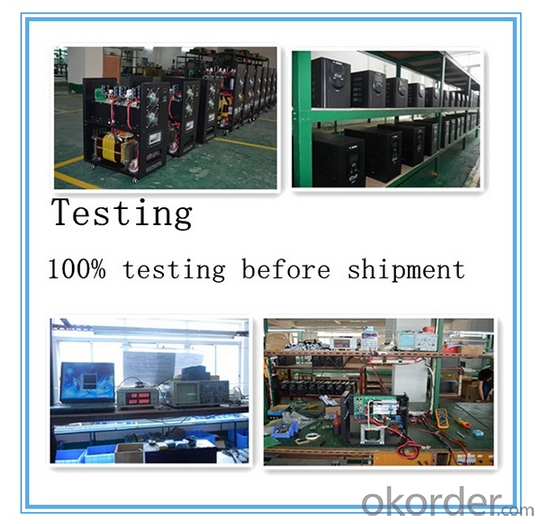
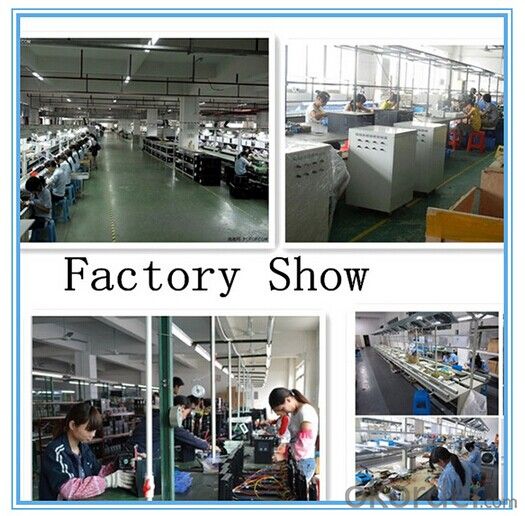
Product Parameter
| Specification: | ||||||||||
| Model XZ-NK | 50112-20 | 10224-30 | 20248-50 | 50296-50 | 70296-50 | 103192-50 | 153192-100 | 203192-100 | ||
| PV Charging Method | Direct Charge/PWM/MPPT | |||||||||
| PV Max input current | 20A | 30A | 50A | 50A | 50A | 50A | 100A | 100A | ||
| PV Rated input voltage | 12VDC | 24VDC | 48VDC | 96VDC | 96VDC | 192VDC | 192VDC | 192VDC | ||
| PV Max input wattage | 240W | 720W | 2400W | 4800W | 4800W | 9600W | 19200W | 19200W | ||
| PV Max input voltage | 18VDC | 36VDC | 72VDC | 144VDC | 144VDC | 288VDC | 288VDC | 288VDC | ||
| PV Charging efficiency | 99% | 99% | 99% | 99% | 99% | 99% | 99% | 99% | ||
| Battery Rated input voltage | 12VDC | 24VDC | 48VDC | 96VDC | 96VDC | 192VDC | 192VDC | 192VDC | ||
| Battery input voltage range | 9VDC-18VDC | 18VDC-36VDC | 36VDC-72VDC | 84VDC-120VDC | 84VDC-120VDC | 168VDC-240VDC | 168VDC-240VDC | 168VDC-240VDC | ||
| Protection function (PV Charge part) | Reverse connection, short circuit, overcharge, anti charge protection | |||||||||
| AC input voltage | 75VAC-125VAC Or 145VAC-275VAC | |||||||||
| AC input frequency | 45HZ-65HZ | |||||||||
| Invert output | 110VAC±2% Or 220VAC±2% | |||||||||
| Invert output Frequency | 50HZ±0.5HZ Or 60HZ±0.5HZ | |||||||||
| Display | LCD | |||||||||
| Rated Capacity | 500W | 1000W | 2000W | 5000W | 7000W | 10000W | 15000W | 20000W | ||
| Inverter structure | Low Frequency Structure | |||||||||
| no-load power consumption | 8W | 15W | 30W | 75W | 75W | 150w | 150W | 150W | ||
| Conversion efficiency | ≥85% | |||||||||
| Mains input charging current | 0-15A(Adjustable) | |||||||||
| Working mode | AC first /PV first(Optional) | |||||||||
| Conversion time | ≤4ms | |||||||||
| Overload capacity | Overload exceeds 110%,automatic shutdown in 30 secs;Overload exceeds 120%,automatic shutdown in 2 secs;Under mains supply mode, it will not shutdown. | |||||||||
| Output waveform | Pure sine wave | |||||||||
| Work environment | Temperature0-40℃,Humidity10-90% | |||||||||
| Thermal methods | Forced Air Cooling | |||||||||
| Protection function (inverter part) | mains over / under-voltage, higher DC current/ under-voltage, short circuit of inverter output | |||||||||
| Output waveform distortion | ≤3% | |||||||||
| Size | Product Size(mm) | 300×170×280 | 422×225×360 | 491×281×430 | 580×350×700 | |||||
| Packing Size(mm) | 350×220×330 | 472×275×410 | 551×341×490 | 660×410×740 | ||||||
| KG | 8KG | 10KG | 18KG | 36KG | 48KG | 55KG | 75KG | 95KG | ||
| Note | All specifications are subject to change without prior notice | |||||||||
- Q: What is the role of inverters in a solar energy system?
- The role of inverters in a solar energy system is to convert the direct current (DC) electricity produced by solar panels into alternating current (AC) electricity that can be used to power common household appliances and be fed into the electrical grid.
- Q: Can solar energy systems be used to power an entire household?
- Yes, solar energy systems can be used to power an entire household. With sufficient solar panels and a properly sized battery storage system, a solar energy system can generate enough electricity to meet the energy needs of a household. Additionally, excess energy produced during the day can be stored in batteries and used during nighttime or cloudy days, ensuring a continuous power supply.
- Q: How do solar energy systems affect the carbon footprint?
- Solar energy systems have a significant positive impact on reducing carbon footprint. By harnessing the sun's energy to generate electricity, solar systems eliminate the need for fossil fuels, which are major contributors to carbon dioxide emissions. This clean and renewable source of energy not only helps combat climate change but also reduces air pollution and dependency on non-renewable resources.
- Q: Can solar energy systems be used in powering outdoor signage or billboards?
- Indeed, outdoor signage or billboards can be powered by solar energy systems. By placing solar panels on the roof or nearby structures, sunlight can be captured and transformed into electricity. This generated electricity is then employed to illuminate the lights or operate the digital displays of the signage or billboards, enabling them to function autonomously without relying on the conventional power grid. Given their prevalence in sun-drenched areas, solar energy systems are especially well-suited for outdoor signage. Moreover, utilizing solar energy aids in mitigating the carbon footprint linked to traditional methods of electricity production, rendering it an eco-friendly alternative.
- Q: Can solar energy systems be used for powering shopping malls or retail centers?
- Yes, solar energy systems can be used to power shopping malls or retail centers. Solar panels can be installed on the rooftops or parking lots of these establishments to generate clean and renewable energy. This can significantly reduce their reliance on traditional energy sources and lower their carbon footprint. Additionally, solar energy systems can help offset electricity costs for these commercial buildings, making them more sustainable and cost-effective in the long run.
- Q: Are there any risks of electrical surges or voltage fluctuations with solar energy systems?
- Solar energy systems come with potential risks of electrical surges or voltage fluctuations. Although the solar panels themselves do not cause these issues, integrating the systems with the existing electrical grid can present challenges. One risk arises from sudden changes in sunlight intensity, which can lead to voltage fluctuations. For instance, when a cloud passes over a solar panel, the abrupt decrease in sunlight can result in a drop in voltage output. Conversely, when the cloud passes, the sudden increase in sunlight can cause a surge in voltage output. These fluctuations have the potential to impact the stability of the electrical grid. Another risk is associated with the inverters utilized in solar energy systems. Inverters convert the direct current (DC) produced by solar panels into alternating current (AC), which is compatible with the electrical grid. Inverter failure or malfunction can cause voltage fluctuations or surges, potentially damaging electrical equipment or disrupting the electrical supply. To address these risks, solar energy systems typically include protective devices such as surge protectors and voltage stabilizers. Surge protectors divert excess energy away from the system to prevent voltage spikes, while voltage stabilizers regulate voltage levels to ensure a steady and safe supply of electricity. Furthermore, proper installation and regular maintenance of solar energy systems are crucial in minimizing the risks of electrical surges or voltage fluctuations. Qualified professionals should handle the installation process, ensuring correct connections and grounding of all components. Routine inspections and maintenance checks can help identify and resolve any issues before they escalate into serious problems. In conclusion, while solar energy systems offer many benefits, it is important to acknowledge and address the potential risks associated with electrical surges or voltage fluctuations. By implementing suitable protective devices, following proper installation and maintenance procedures, and collaborating with qualified professionals, these risks can be effectively managed, guaranteeing the safe and reliable operation of solar energy systems.
- Q: Can solar energy systems be used for powering outdoor lighting?
- Yes, solar energy systems can be used effectively for powering outdoor lighting. Solar-powered outdoor lighting systems are designed to capture sunlight during the day and convert it into electricity, which is stored in batteries. This stored energy is then used to power the outdoor lights during the night, making them energy-efficient and environmentally friendly. Additionally, solar-powered outdoor lighting systems do not require extensive wiring or electrical connections, making them easy to install and maintain.
- Q: Can solar energy systems be used for powering electric car manufacturing plants?
- Indeed, electric car manufacturing plants can utilize solar energy systems. These systems harness the power of sunlight to generate electricity, which can then be utilized for diverse industrial operations, including the functioning of manufacturing plants. By implementing solar panels on the rooftops or open areas of the manufacturing facility, the plant can effectively tap into renewable energy to satisfy its electricity requirements. This not only diminishes the dependency on fossil fuels but also aids in curbing greenhouse gas emissions linked to conventional electricity generation. Moreover, by integrating energy storage solutions, solar energy systems ensure a consistent power supply, even during periods of limited sunlight or nighttime. Consequently, opting for solar energy systems to power electric car manufacturing plants is a sustainable and environmentally conscious decision.
- Q: How do solar energy systems impact the health and well-being of communities?
- Solar energy systems have a significant positive impact on the health and well-being of communities. One of the most significant benefits is the reduction in air pollution. Traditional energy sources such as coal and natural gas emit harmful pollutants that can cause respiratory problems, cardiovascular diseases, and even cancer. Solar energy systems produce clean and renewable energy, resulting in reduced air pollution and improved air quality. By reducing reliance on fossil fuels, solar energy systems also contribute to mitigating climate change. Climate change has numerous adverse health effects, including increased heat-related illnesses, the spread of infectious diseases, and food and water scarcity. Solar energy helps in reducing greenhouse gas emissions, which in turn helps to combat climate change and protect the health of communities. Moreover, solar energy systems have positive economic impacts on communities. They create job opportunities in the installation, maintenance, and manufacturing sectors. These jobs not only provide income but also contribute to the well-being of individuals and families. Additionally, solar energy systems can reduce electricity costs for households, freeing up financial resources that can be utilized for other essential needs, such as healthcare and education. Solar energy systems also enhance the resilience and reliability of energy supply in communities. They are decentralized and can be installed on rooftops or in smaller-scale installations, reducing the vulnerability of communities to power outages caused by natural disasters or infrastructure failures. This reliability ensures that critical services such as hospitals, schools, and emergency response centers can continue to function during power disruptions, ultimately protecting the health and safety of community members. Furthermore, solar energy systems promote energy independence and energy equity. Communities that have limited access to reliable electricity can benefit from solar energy systems, which can be installed in remote or underserved areas. This improves the quality of life for individuals in these communities by providing them with access to clean and affordable energy. In conclusion, solar energy systems have a profound impact on the health and well-being of communities. By reducing air pollution, mitigating climate change, creating jobs, enhancing energy resilience, and promoting energy equity, solar energy systems contribute to healthier and more sustainable communities.
- Q: How do solar energy systems impact the efficiency of air conditioning systems?
- Solar energy systems can greatly impact the efficiency of air conditioning systems by reducing the reliance on traditional power sources. By harnessing the sun's energy, solar systems can provide clean and renewable electricity to power air conditioners, reducing costs and environmental impact. Additionally, solar energy can be stored and used during peak demand, ensuring a consistent power supply for efficient cooling.
Send your message to us
Solar Energy Systems Maine:Solar Generator Intelligent Inverter with Charger
- Loading Port:
- Guangzhou
- Payment Terms:
- TT OR LC
- Min Order Qty:
- 50 pc
- Supply Capability:
- 100000 pc/month
OKorder Service Pledge
OKorder Financial Service
Similar products
Hot products
Hot Searches
Related keywords
